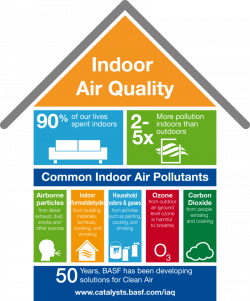Indoor Air Quality (IAQ)
The Deschutes County Environmental Health Department’s Indoor Air Quality Program was developed to improve the health of Deschutes County’s residents by reducing exposure to indoor air contaminants. The primary function of this program is to provide advice and technical assistance for existing or potential indoor air hazards and help people access indoor air quality testing, prevention and mitigation resources. The IAQ program can assist businesses, organizations, day cares, schools, health care settings and other public facilities with a focus on vulnerable populations.
Ensuring proper ventilation can help reduce indoor airborne contaminants including viruses, such as SARS-CoV-2 that causes COVID-19. Studies have shown that the transmission of Covid-19 increases in spaces with inadequate ventilation and airflow. A few simple actions can reduce the risk of viral transmission, improve the air quality inside your home or building and lessen your exposure to a variety of indoor air hazards including wildfire smoke.

What you can do now
Good Outdoor Air Quality – Not Smoky
- Open windows and doors to let in fresh air
- Increase amount of outdoor air pulled through HVAC system
- Clean to get rid of dust and pet fur
- Do not smoke inside
- Have your HVAC system evaluated by a specialist
- Use MERV 13 filters
- Use portable HEPA air cleaners
- Reduce occupancy
Smoky Outside or poor outdoor air quality
- Reduce amount of time spent outdoors
- Close windows and doors
- Set your HVAC system to recirculating air through the filter
- Use high efficiency MERV 13 filters
- Wear N95 mask
- Use portable HEPA air cleaners
- Make your own box fan air filter
- Avoid smoking tobacco, using wood-burning stoves, burning candles or vacuuming
- Stay well hydrated
- If you have heart or lung disease or respiratory illness , follow your health care provider's recommendations

IAQ Assessments
Deschutes County can provide technical assistance to improve indoor air quality via a phone consultation or site visit. Please request assistance by completing this form and determine your eligibility to receive a free Radon Test Kit. These assessments measure common indoor contaminants and are generalized air quality profiles only. We do not provide professional HVAC or engineering evaluations. If you have special health concerns or respiratory illness contact your health care provider. Our IAQ assessment will give you a report and help identify possible sources, potential remedies and provide referrals to professional HVAC resources. Fill out the Indoor Air Quality Assistance Request Form

Temperature and Humidity: The American Society of Heating, Refrigerating, and Air Conditioning Engineers (ASHRAE) provides guidelines that are intended to satisfy the majority of building occupants wearing a normal amount of clothing while working at a desk. The ASHRAE guidelines recommend 68 F to 74 F in the winter and 72 F to 80 F in the summer. The ASHRAE guidelines recommend a relative humidity (RH) of 30 to 60 percent. While lower humidity may discourage pests, mold and bacterial growth, higher humidity causes virus particles to decay faster leading to reduced risk of infection.

Carbon Monoxide (CO): is an odorless, colorless gas that is a by-product of the incomplete burning of fuels containing carbon such as wood, gas and oil. Sources include heating appliances such as kerosene and gas space heaters; leaking chimneys and furnaces; back-drafting from furnaces, gas water heaters, wood stoves, and fireplaces. At low concentrations, fatigue in healthy people and chest pain in people with heart disease. At higher concentrations, impaired vision and coordination; headaches; dizziness; confusion; nausea. Can cause flu-like symptoms that clear up after leaving home and can be fatal at very high concentrations.

Carbon Dioxide (CO2): is a colorless, odorless, non-flammable gas that naturally occurs in the atmosphere. CO2 is produced by body metabolism and is a normal component of exhaled breath. It also results from the burning of fossil fuels and natural sources such as volcanic eruptions. CO2 levels in outdoor air typically range from 300 to 400 ppm but can be as high as 600-900 ppm in metropolitan areas.
Occupants may experience health effects in buildings where CO2 is elevated. At high levels, the carbon dioxide itself can cause headache, dizziness, nausea and other symptoms. This could occur when exposed to levels above 5,000 ppm for many hours. At even higher levels of CO2 can cause asphyxiation as it replaces oxygen in the blood-exposure to concentrations around 40,000 ppm is immediately dangerous to life and health.

Particulates (PM2.5/PM10): Airborne particulate matter, often caused by wildfire smoke and vehicle exhaust, are tiny solid or aerosol particles that can be inhaled and have harmful health effects. Exposure to inhalable particles can affect both your lungs and your heart. Small particles (less than 10 micrometers in diameter) can get deep into your lungs, and some may even get into your bloodstream. People with heart or lung diseases such as coronary artery disease, congestive heart failure, and asthma or chronic obstructive pulmonary disease (COPD), children and older adults may be at greater risk from PM exposure.

Chemicals (TVOC): Volatile Organic Compounds (VOCs) are a large group of chemicals that are found in many products we use to build and maintain our homes. Once these chemicals are in our homes, they are released or “off-gas” into the indoor air we breathe. They may or may not be able to be smelled, and smelling is not a good indicator of health risk.
Common examples of VOCs that may be present in our daily lives are: benzene, ethylene glycol, formaldehyde, methylene chloride, tetrachloroethylene, toluene, and xylene.
Infographics
Sources of Indoor air pollutants:
https://www.floridamoldtesting.net/wp-content/uploads/2018/09/IAQ-infographic-image.jpg
DIY box fan filter:

